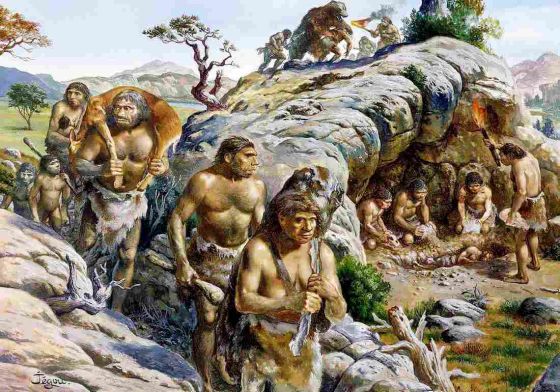Difference between revisions of "Palaeolithic Period"
Tao alexis (talk | contribs) |
Tao alexis (talk | contribs) |
||
| Line 5: | Line 5: | ||
About this time, some 18 thousand <small>BC</small>, [[Dwarf Race & Physiology|dwarven]] cultures took shape and acquired life from the flesh of the Ymir, a primordial deity that was ancestor also to the "jotnar," or [[Giant|giants]]. Primitive forms of these humanoids arose more or less at the same time as the dwarves. | About this time, some 18 thousand <small>BC</small>, [[Dwarf Race & Physiology|dwarven]] cultures took shape and acquired life from the flesh of the Ymir, a primordial deity that was ancestor also to the "jotnar," or [[Giant|giants]]. Primitive forms of these humanoids arose more or less at the same time as the dwarves. | ||
| + | |||
| + | Ice ages occurred throughout the Paleolithic, though the effect of the last glacial period (25,000 to 12,000 <small>BC</small>) is known. | ||
== Human Culture == | == Human Culture == | ||
| Line 13: | Line 15: | ||
For a time, humans and [[Neanderthal|neanderthals]] co-existed, sharing similar environments and competing for resources. Conflict did occur between the two races, with the neanderthal virtually disappearing ... though tribes of "cavemen" have been found in the remotest parts of the world. It's not probable that early neanderthals escaping into the earth's caves brought about the beginnings of svirfneblin culture, though the fall of one culture and the rise of the other do suggest the possibility. | For a time, humans and [[Neanderthal|neanderthals]] co-existed, sharing similar environments and competing for resources. Conflict did occur between the two races, with the neanderthal virtually disappearing ... though tribes of "cavemen" have been found in the remotest parts of the world. It's not probable that early neanderthals escaping into the earth's caves brought about the beginnings of svirfneblin culture, though the fall of one culture and the rise of the other do suggest the possibility. | ||
| − | With the Upper Paleolithic came advancements in tool technology and an emergence of symbolic thinking and art (intricate cave paintings and figures). Expansion into Polynesia (40,000 <small>BC</small>) and the New World (15 to 16,000 <small>BC</small>) led to the present day extent of humans around the globe. | + | With the Upper Paleolithic came advancements in tool technology and an emergence of symbolic thinking and art (intricate cave paintings and figures). Expansion into Polynesia (40,000 <small>BC</small>) and the New World (15 to 16,000 <small>BC</small>) led to the present day extent of humans around the globe. Populations during the time period were small; it's been estimated that following the maximal height of the last glacial period, the population of humans may have dipped as low as 30,000 individuals. |
Revision as of 00:52, 18 August 2023
The Paleolithic Period extends between 200,000 years ago and 12,000 BC. The Lower period reaches from 200,000 to 40,000 years ago; the Upper period begins after that. Through most of the Lower Paleolithic, only human race dwelt upon the game world's Earth, primarily in East Africa. Late in the Lower period, primeval elves began appearing in the lands of Anduin, in the far extreme of Siberia, sometime between 50 and 45 thousand BC.
Contents
After the outset of the Upper period, it's believed — but not known for certain — that the first svirfneblin began to spawn beneath Europe between 30 and 27 thousand BC. Ten thousand years later, sometime between 20 and 18 thousand BC, scattered cave peoples began to appear in east central Asia, radiating outwards from the Kodar Mountains — bugbears, ogres and orcs ... then, some 15 to 14 thousand BC, hobgoblins, goblins and xvarts.
About this time, some 18 thousand BC, dwarven cultures took shape and acquired life from the flesh of the Ymir, a primordial deity that was ancestor also to the "jotnar," or giants. Primitive forms of these humanoids arose more or less at the same time as the dwarves.
Ice ages occurred throughout the Paleolithic, though the effect of the last glacial period (25,000 to 12,000 BC) is known.
Human Culture
- Main Article: Humans in the Paleolithic Period
Humans as we know them began to appear in Africa at the start of the Lower Paleolithic, though proto-humanoid cultures had spread into what is now China, Sumatra and Java, and around the Mediterranean. Anatomically modern humans exhibited more advanced cognitive abilities, complex tool making and art. Between 70 and 60 thousand BC, advanced humans began migrating out of Africa and populating other parts of the world; at that time, they were primarily hunter-gatherers, relying on fishing, stone tools and creating cave art.
For a time, humans and neanderthals co-existed, sharing similar environments and competing for resources. Conflict did occur between the two races, with the neanderthal virtually disappearing ... though tribes of "cavemen" have been found in the remotest parts of the world. It's not probable that early neanderthals escaping into the earth's caves brought about the beginnings of svirfneblin culture, though the fall of one culture and the rise of the other do suggest the possibility.
With the Upper Paleolithic came advancements in tool technology and an emergence of symbolic thinking and art (intricate cave paintings and figures). Expansion into Polynesia (40,000 BC) and the New World (15 to 16,000 BC) led to the present day extent of humans around the globe. Populations during the time period were small; it's been estimated that following the maximal height of the last glacial period, the population of humans may have dipped as low as 30,000 individuals.
